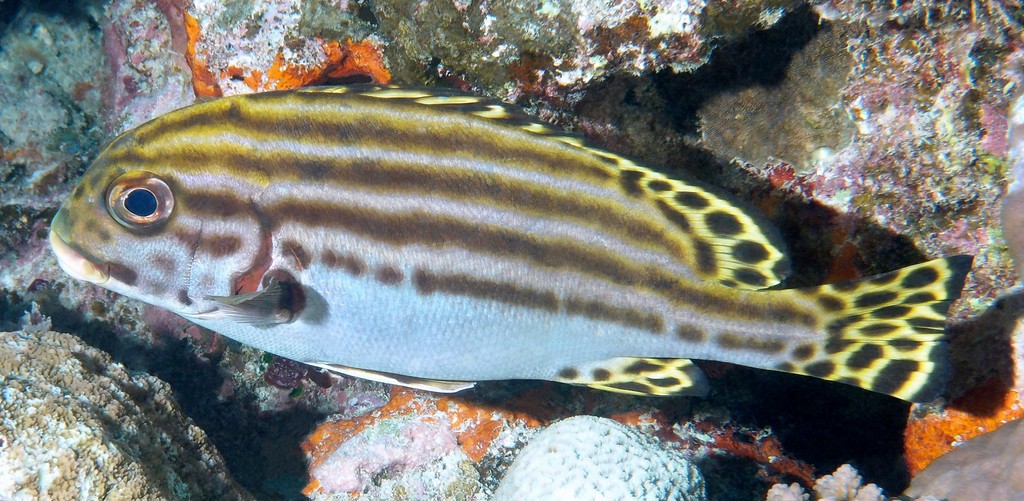PLECTORHINCHUS LESSONII - (CUVIER, 1830)
Actinopterygii (Gigaclass) > Actinopteri (Class) > Teleostei (Subclass) > Acanthuriformes (Order) > Haemulidae (Family) > Plectorhinchinae (Subfamily) > Plectorhinchus (Genus)
Diagramme de Lesson, Gaterin de Lesson, Gaterin rayé, Lesson's sweetlips, Lesson's thicklip, Lesson’s thick lip, Lined sweetlips, Striped sweetlips, Hiregurokoshodai, ヒレグロコショウダイ, 少耙胡椒鲷,
Synonyme
Diagramma lessonii (Cuvier, 1830)
--------------------------
Description
Dorsal spines (total): 12-13; Dorsal soft rays (total): 18-22; Anal spines: 3; Anal soft rays: 7-8; Pectoral fin rays: 16-18; Lateral line scales: 53-56. Body compressed, oblong. Head strongly obtuse, upper profile well convex. Eye moderate. Mouth small, horizontal, upper jaw protractile. Lips fleshy. Jaws with bands of villiform teeth, pointed, in 4 rows. Chin with three pairs of pores. Preopercle serrate. No opercular spine. Branchiostegal rays 6. Scales moderate, ctenoid. Max. length: 40.0 cm TL. Depth range: 1 - 35 m.
Diagramme de Lesson, Gaterin de Lesson, Gaterin rayé, Lesson's sweetlips, Lesson's thicklip, Lesson’s thick lip, Lined sweetlips, Striped sweetlips, Hiregurokoshodai, ヒレグロコショウダイ, 少耙胡椒鲷,
Synonyme
Diagramma lessonii (Cuvier, 1830)
--------------------------
Description
Dorsal spines (total): 12-13; Dorsal soft rays (total): 18-22; Anal spines: 3; Anal soft rays: 7-8; Pectoral fin rays: 16-18; Lateral line scales: 53-56. Body compressed, oblong. Head strongly obtuse, upper profile well convex. Eye moderate. Mouth small, horizontal, upper jaw protractile. Lips fleshy. Jaws with bands of villiform teeth, pointed, in 4 rows. Chin with three pairs of pores. Preopercle serrate. No opercular spine. Branchiostegal rays 6. Scales moderate, ctenoid. Max. length: 40.0 cm TL. Depth range: 1 - 35 m.
Color
Juvenile with three broad black stripes and narrower yellow white band between them.
Adulte: body white with four Irish dark brown strips on upper side; Dorsal, caudal, and anal fins are dusky with the color of yellow and brown. A large black spot on the upper portion of pectoral finbase; Ventral fin small, not reaching anus. Abdomen white.
Etymology
Plectorhinchus: from ancient Greek, pleko = I plait, braid twist, bend, turn + from Greek, rhynchos = one having a snout, bill, or beak. Referring to skin folds on snout folded into upper lip of Plectorhinchus chaetodonoides.
lessonii: named in honnor of René Primevère Lesson (1794–1849) who was a French surgeon, naturalist, ornithologist, and herpetologist.
Original description: Diagramma lessonii Cuvier, 1830 - Type locality: Waigeo, Indonesia.
Distribution
Southeastern Indian Ocean, western Pacific: Indonesia, east to New Ireland (Papua New Guinea), north to Amami Islands (southern Japan) and Ogasawara islands, south to East Indies to Great Barrier Reef (Queensland, Australia) and New Caledonia.
Biology
Inner and outer reef lagoons, usually in caves along steep slopes. Juveniles in shallow lagoons or protected shallow reefs. During the day, occurs under coral ledges of channel and outer reef slopes. Solitary. Oviparous, distinct pairing during breeding.
Juvenile with three broad black stripes and narrower yellow white band between them.
Adulte: body white with four Irish dark brown strips on upper side; Dorsal, caudal, and anal fins are dusky with the color of yellow and brown. A large black spot on the upper portion of pectoral finbase; Ventral fin small, not reaching anus. Abdomen white.
Etymology
Plectorhinchus: from ancient Greek, pleko = I plait, braid twist, bend, turn + from Greek, rhynchos = one having a snout, bill, or beak. Referring to skin folds on snout folded into upper lip of Plectorhinchus chaetodonoides.
lessonii: named in honnor of René Primevère Lesson (1794–1849) who was a French surgeon, naturalist, ornithologist, and herpetologist.
Original description: Diagramma lessonii Cuvier, 1830 - Type locality: Waigeo, Indonesia.
Distribution
Southeastern Indian Ocean, western Pacific: Indonesia, east to New Ireland (Papua New Guinea), north to Amami Islands (southern Japan) and Ogasawara islands, south to East Indies to Great Barrier Reef (Queensland, Australia) and New Caledonia.
Biology
Inner and outer reef lagoons, usually in caves along steep slopes. Juveniles in shallow lagoons or protected shallow reefs. During the day, occurs under coral ledges of channel and outer reef slopes. Solitary. Oviparous, distinct pairing during breeding.
Similar species
Plectorhinchus albovittatus (Rüppell, 1838) - Reported from New Caledonia - Link to the species (here). Juveniles of Plectorhinchus lessonii resemble Plectorhinchus albovittatus with three reddish brown stripes and white circular areas on the upper part of the body.
Plectorhinchus vittatus (Linnaeus, 1758) - Reported from New Caledonia - Link to the species (here). Adults resemble Plectorhinchus vittatus, but lack stripes on the belly, with greenish black stripes over the back. In Plectorhinchus vittatus, the body color is silver-white with black stripes and horizontal stripes running laterally across the body (from the head to the tail, including the fins).
Plectorhinchus albovittatus (Rüppell, 1838) - Reported from New Caledonia - Link to the species (here). Juveniles of Plectorhinchus lessonii resemble Plectorhinchus albovittatus with three reddish brown stripes and white circular areas on the upper part of the body.
Plectorhinchus vittatus (Linnaeus, 1758) - Reported from New Caledonia - Link to the species (here). Adults resemble Plectorhinchus vittatus, but lack stripes on the belly, with greenish black stripes over the back. In Plectorhinchus vittatus, the body color is silver-white with black stripes and horizontal stripes running laterally across the body (from the head to the tail, including the fins).
Last update: 1, April 2023
